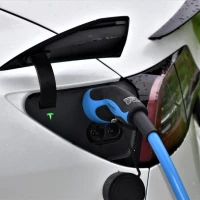The era of electric vehicles (EVs) is here, and it’s reshaping how we think about transportation. With the increase in EV popularity, the demand for convenient and efficient charging solutions at home is on the rise. NEMA 6-50 installation cost can be a concern for many EV owners, but there’s good news: slashing those costs is achievable through DIY installations. This comprehensive guide will walk you through the process of setting up a NEMA 6-50 outlet for your EV charging needs on a budget.
Electric vehicle ownership no longer means you are tethered to high costs and limited charging stations. By taking the DIY route and learning about the intricacies of NEMA 6-50 installation, you can enjoy the benefits of at-home charging without breaking the bank. In the upcoming sections, we will delve into the essentials of electric vehicle charging, the benefits of a NEMA 6-50 setup, and provide a step-by-step guide to managing installation costs effectively.
Understanding the NEMA 6-50 Standard for EV Charging
Before diving into the details of installation and cost management, it’s crucial to understand what a NEMA 6-50 outlet is and why it is becoming an at-home charging staple for electric vehicle owners.
What is a NEMA 6-50 Outlet?
A NEMA 6-50 outlet is an electrical receptacle that adheres to the standards set by the National Electrical Manufacturers Association (NEMA). It is a 240-volt plug commonly used for heavy-duty applications such as welding equipment and, pertinently, electric vehicle charging. This type of outlet can provide faster charging times for EVs compared to standard 120-volt household outlets.
- Higher Voltage: Allows for more efficient power transfer and quicker charging.
- Heavy-Duty Design: Suitable for high-current appliances, providing durability and safety.
- Widely Compatible: Many EV chargers are designed to be compatible with NEMA 6-50 outlets.
Benefits of Installing a NEMA 6-50 Outlet for EV Charging
Opting for a NEMA 6-50 installation for your electric vehicle charging comes with several advantages, but let’s spotlight the most impactful ones:
- Accelerated Charging Speeds: The capability to handle more power means faster charging, reducing downtime for your vehicle.
- Long-term Cost Savings: By bringing the convenience of EV charging to your home, you minimize your dependence on public charging stations and the associated costs.
- Increased Home Value: Adding a NEMA 6-50 outlet for EV charging can be an attractive feature for future homebuyers, should you decide to sell.
DIY vs. Professional NEMA 6-50 Installation: Navigating Costs
When it comes to installing a NEMA 6-50 outlet, you are faced with the choice of hiring a professional or taking on the project yourself. Here’s how these options stack up, especially in terms of cost.
Cost Benefits of DIY NEMA 6-50 Installation
- No Labor Costs: You save on the significant labor expenses that come with professional installations.
- Learn Valuable Skills: DIY installation provides you with electrical knowledge that can be applied to future home projects.
- Control Over Materials: You can source cost-effective materials and avoid markups from contractors.
Considering Professional Installation
While DIY can save costs, it’s essential not to undermine the value of a professional installation, which guarantees:
- Safety Assurance: A licensed electrician will ensure that the installation adheres to safety codes and local regulations.
- Quality of Work: Professionals bring experience that translates to a reliable setup.
Step-by-Step Guide to DIY NEMA 6-50 Installation
Unlocking the benefits of a DIY NEMA 6-50 installation requires a detailed understanding of the process. Let’s walk you through the steps, highlighting the aspects where you can shave off costs while maintaining quality and safety.
Assessing Your Electrical System’s Capacity
Meticulously audit your home’s electrical system to confirm that it can support a NEMA 6-50 outlet without necessitating a costly upgrade.
- Review your main circuit panel capacity to ensure available amperage for the new circuit.
- Check local codes and regulations to comply with requirements and avoid fines.
Gathering Your Tools and Materials
By carefully selecting and purchasing your tools and materials, you can sidestep unnecessary expenses without compromising on the quality of your installation.
- Choose a suitable NEMA 6-50 outlet and corresponding circuit breaker.
- Find cost-effective wiring that meets the electrical requirements.
The Installation Process
- Turn Off Power: Ensure your safety by shutting off the main power to your home before beginning the installation.
- Install the Circuit Breaker: Fit the appropriate circuit breaker into your panel, readying it for the new outlet circuit.
- Run the Wiring: Route the wiring from the panel to the location of your new NEMA 6-50 outlet, following safety practices.
- Connect the Outlet: Attach the wires to the NEMA 6-50 outlet, observing proper polarity.
- Test the Installation: Once everything is in place, restore power and test the outlet for correct operation before regular use.
Maximizing Cost-Efficiency with Budget-Friendly NEMA 6-50 Accessories
Even beyond the installation, there are opportunities to curtail costs through intelligent choices regarding accessories and ongoing usage.
EVSE (Electric Vehicle Supply Equipment) Considerations
Purchasing an EVSE that is NEMA 6-50 compatible can be a substantial expenditure. However, there are ways to balance quality with economy:
- Look for Deals: Research and take advantage of discounts or EV charging incentives.
- Consider Refurbished Equipment: Certified refurbished units can offer significant savings.
Ongoing Usage and Maintenance
After installation, prolong the life of your NEMA 6-50 outlet and associated equipment with good practices:
- Routinely check connections for signs of wear or damage.
- Invest in protective equipment like surge protectors to safeguard against electrical irregularities.
Troubleshooting and Safety Measures for NEMA 6-50 Outlets
Installing a NEMA 6-50 outlet for your electric vehicle is a significant undertaking that should be approached with rigor, especially when focusing on keeping costs low.
Preventative Safety Tips
- Always prioritize adhering to electrical codes and regulations.
- Use safety gear such as gloves and eye protection during the installation process.
Troubleshooting Common Issues
Be prepared to handle potential issues that may arise with your NEMA 6-50 installation:
- Incorrect Wiring: Double-check connections against the outlet’s wiring diagram.
- Circuit Overloads: Ensure the circuit has the necessary capacity and doesn’t serve other high-load appliances.
Conclusion: DIY NEMA 6-50 Installation as a Key to EV Charging Savings
By embracing the DIY ethos and applying the guidance provided here, you are now empowered to approach NEMA 6-50 installation cost management with confidence. A well-executed DIY project can not only bring down the upfront costs of setting up a home EV charging station but also provide ongoing savings, making your electric vehicle experience both accessible and affordable.
Whether you are an EV enthusiast looking to enhance your charging setup or a newcomer seeking budget-friendly solutions, investing time in a DIY NEMA 6-50 outlet installation can pay dividends. Keep this article as a resource and reminder that with careful planning and attention to detail, you can achieve professional-level results and significant cost savings, granting you greater control over your electric vehicle’s charging capabilities.










